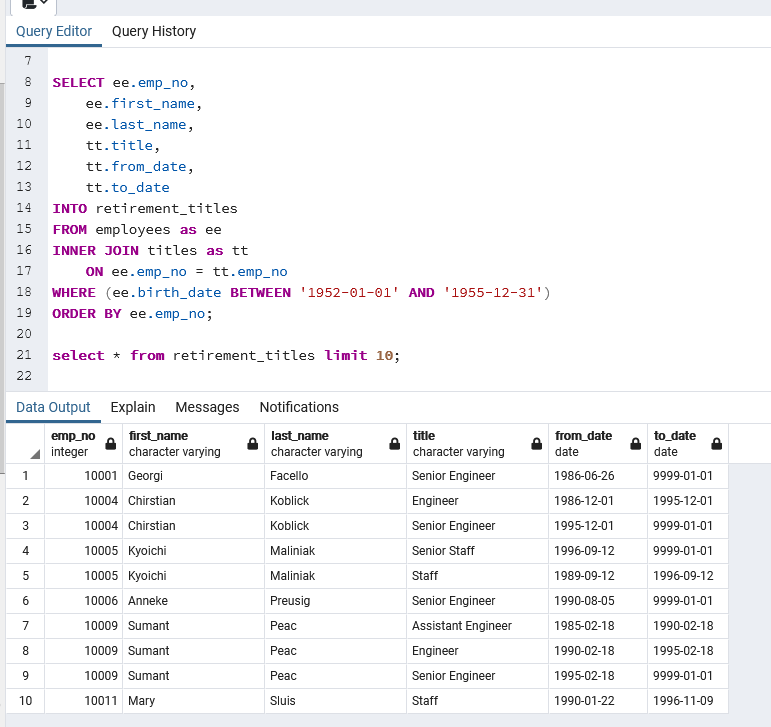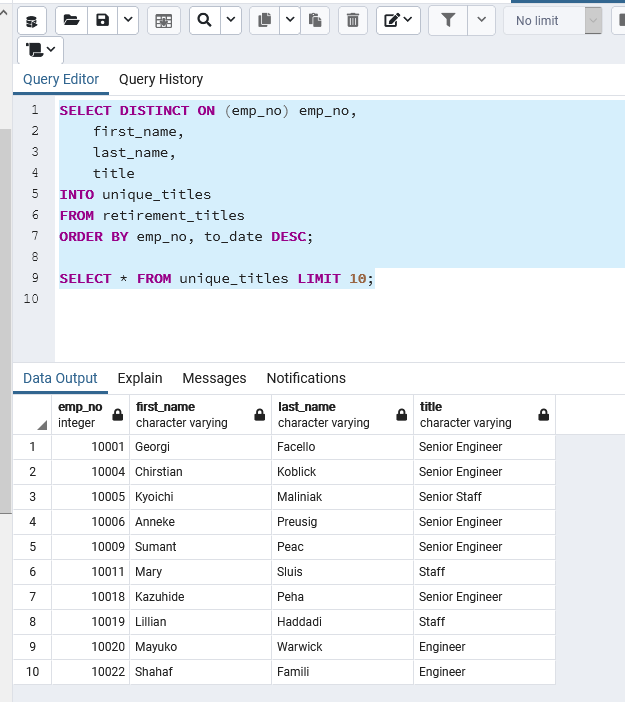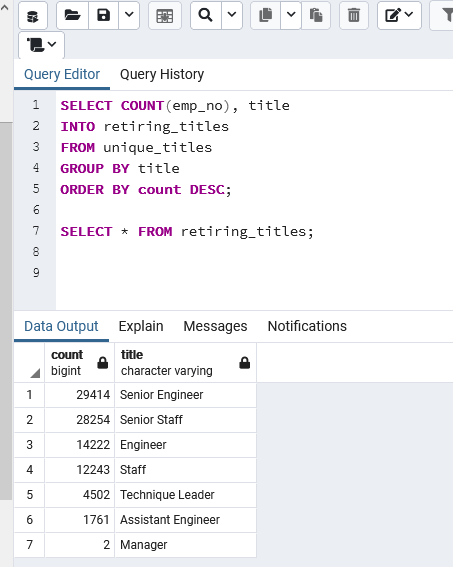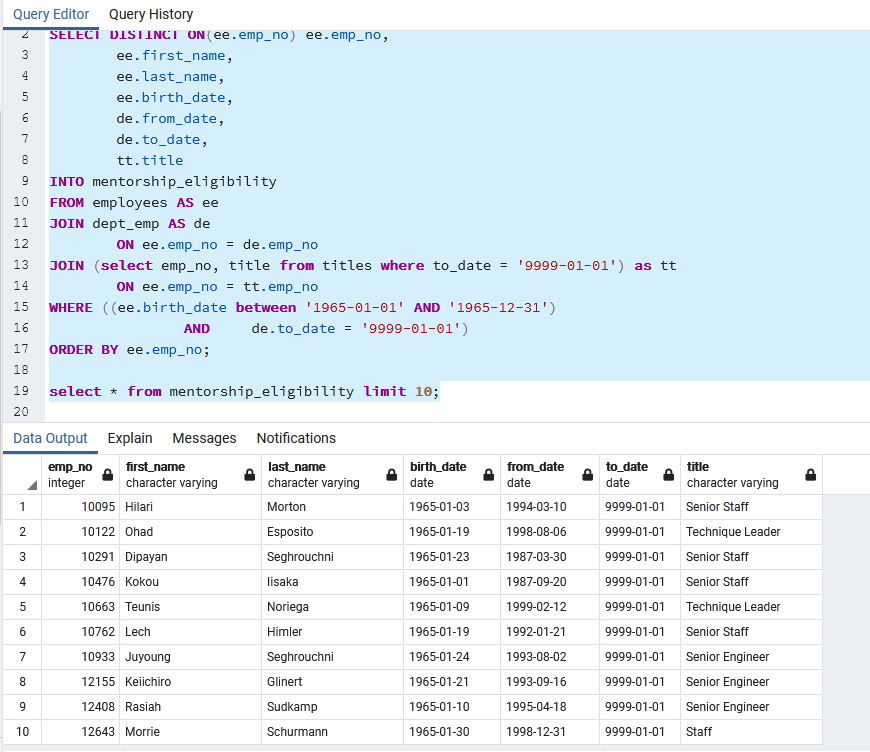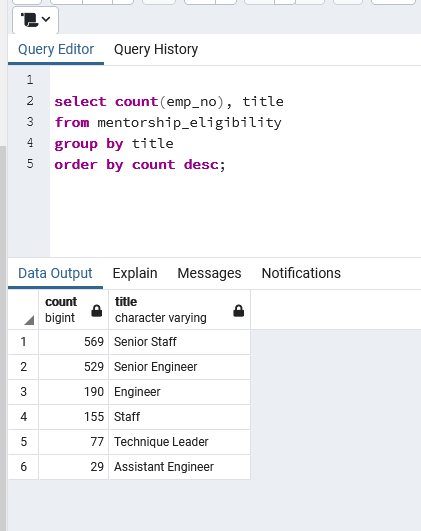The purpose of this analysis is to:
- determine the number of retiring employees per title
- identify employees who are eligible to participate in a mentorship program.
We performed our analysis by completing the following steps.
Entity Relationship Diagram (Physical) created with http://quickdatabasedagrams.com
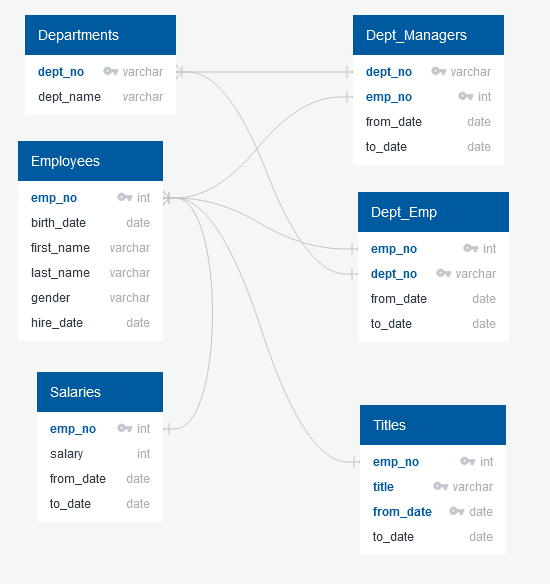
Pewlett-Hackard Database Schema for Postgresql
CREATE TABLE departments (
dept_no VARCHAR(4) NOT NULL,
dept_name VARCHAR(40) NOT NULL,
PRIMARY KEY (dept_no),
UNIQUE (dept_name)
);
CREATE TABLE employees (
emp_no INT NOT NULL,
birth_date DATE NOT NULL,
first_name VARCHAR NOT NULL,
last_name VARCHAR NOT NULL,
gender VARCHAR NOT NULL,
hire_date DATE NOT NULL,
PRIMARY KEY (emp_no)
);
CREATE TABLE dept_manager (
dept_no VARCHAR(4) NOT NULL,
emp_no INT NOT NULL,
from_date DATE NOT NULL,
to_date DATE NOT NULL,
FOREIGN KEY (emp_no) REFERENCES employees (emp_no),
FOREIGN KEY (dept_no) REFERENCES departments (dept_no),
PRIMARY KEY (emp_no, dept_no)
);
CREATE TABLE salaries (
emp_no INT NOT NULL,
salary INT NOT NULL,
from_date DATE NOT NULL,
to_date DATE NOT NULL,
FOREIGN KEY (emp_no) REFERENCES employees (emp_no),
PRIMARY KEY (emp_no)
);
CREATE TABLE dept_emp (
emp_no INT NOT NULL,
dept_no VARCHAR NOT NULL,
from_date DATE NOT NULL,
to_date DATE NOT NULL,
FOREIGN KEY (emp_no) REFERENCES employees (emp_no),
FOREIGN KEY (dept_no) REFERENCES departments (dept_no),
PRIMARY KEY (emp_no, dept_no)
);
CREATE TABLE titles (
emp_no INT NOT NULL,
title VARCHAR NOT NULL,
from_date DATE NOT NULL,
to_date DATE NOT NULL,
FOREIGN KEY (emp_no) REFERENCES employees (emp_no),
PRIMARY KEY (emp_no)
);
SQL code to create the retirement_titles table
SQL code to create the unique_titles table
SQL code to create the retiring_titles table
SQL code to create the mentorship_eligibility table
There are a total of 90,398 employees (out of a total of 300,024) who are eligible for retirement soon. So 30% of the total workforce will leave in the next four years.
| Count | Percent of workforce | |
|---|---|---|
| Total Employees born betwen 1952 - 1955 | 90,398 | 30.13% |
| Employees born in 1952 | 21,209 | 7.07% |
| Employees born in 1953 | 22,857 | 7.62% |
| Employees born in 1954 | 23,228 | 7.74% |
| Employees born in 1955 | 23,104 | 7.70% |
Are there enough qualified, retirement-ready employees in the departments to mentor the next generation of Pewlett Hackard employees?
Counts of employees eligible for mentorship_eligibility
We can compare that with the number of employees available to be mentors below, and we can see that there are plenty of retirement-ready employees to mentor the next generation of PH employees:
| Title | Mentors | Mentees |
|---|---|---|
| Senior Engineer | 29,414 | 529 |
| Senior Staff | 28,254 | 569 |
| Engineer | 14,222 | 190 |
| Staff | 12,243 | 155 |
| Technique Leader | 4,502 | 77 |
| Assistant Engineer | 1,761 | 29 |
| Manager | 2 | 0 |
It actually looks like PH has the opposite problem. There are not enough younger employees to take up the slack when the retirees are gone.
